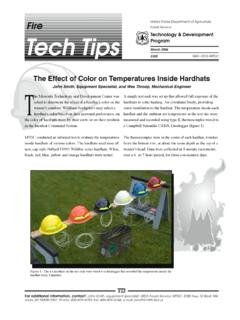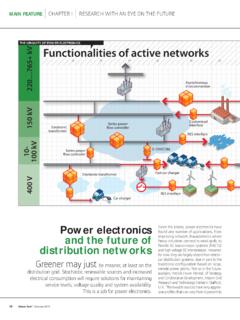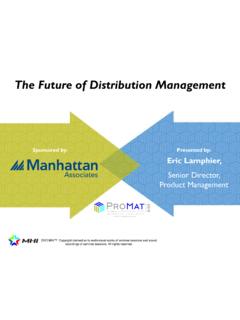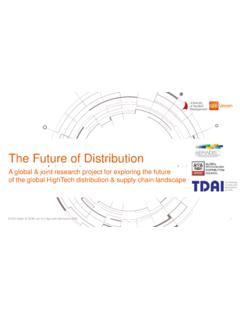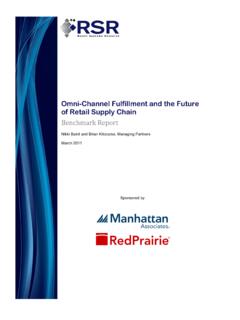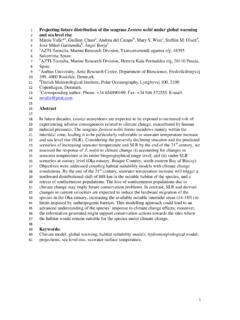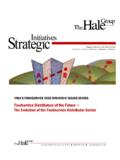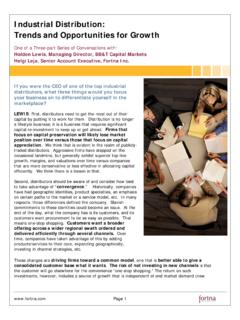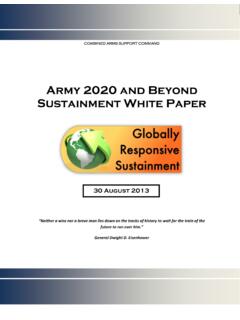Transcription of Predicting the Potential Future Distribution of Four Tree ...
1 ORIGINALARTICLESP redicting the Potential FutureDistribution of Four Tree Species inOhio Using current HabitatAvailability and climatic ForcingMark W. Schwartz,1* Louis R. Iverson,2and Anantha M. Prasad21 Department of Environmental Science and Policy, University of California, Davis, California 95616, USA; and2 USDA ForestService, Northeastern Research Station, Delaware, Ohio 43015, USAABSTRACTWe investigated the effect of habitat loss on theability of trees to shift in Distribution across alandscape dominated by agriculture. The poten-tial Distribution shifts of four tree species (Diospy-ros virginiana, Oxydendron arboreum, Pinus virgini-ana, Quercus ) whose northerndistribution limits fall in the southern third ofOhio were used to assess possible distributionshift scenarios as a result of global warming. Ourpredictions derive from the results of simulationsusing (a) forest inventory based estimates of cur-rent Distribution and abundance of target species;(b) a satellite-based estimate of forest habitatavailability; and (c) a tree migration model(SHIFT).
2 The current Distribution and abundanceof trees was estimated using USDA Forest Ser-vice s Forest Inventory Analysis data and distri-bution maps from the late 1960s; pre-Europeansettlement forest nonforest maps were used torepresent the fully forested condition for calibra-tion and comparison. habitat - availability esti-mates in Ohio were estimated using classifiedLandsat Thematic Mapper (TM) data from abundance, forest availability and migrationwere modeled using a 1-km2pixel size. Forestavailability was estimated as the proportion offorested TM pixels within each cell. The probabil-ity of a migrating species colonizing an unoccu-pied cell is modeled as a function of forest avail-ability and distance to occupied cells. The resultsof the migration models suggest that the speciesstudied are capable of colonizing virtually anyforested location within Ohio over the next 100years if climatic controls over the current distri-bution that may currently inhibit northwardmovement are relaxed.
3 The contiguous distribu-tion of these species, however, is not likely toshift more than 10 km during the next centuryregardless of the magnitude of the climatechange. Examining the sensitivity of our simula-tions by varying critical model attributes, wefound that whereas the variables controlling theamount of long-distance dispersal have strongeffects on migration rates in the fully forested1800 situation, they have significantly lesser ef-fects on projections of Future migration intohighly fragmented forests. The low forest avail-ability that characterizes much of the currentOhio landscape, along with the low likelihood oflong distance dispersal, result in Potential distri-bution shifts that are concentrated within theprincipally forested corridors in southeasternOhio. We propose that in contrast to the past, Future tree migrations are likely to be spatiallyand temporally correlated as a result of largeclimatic forcing and channelization through lim-ited regions of available habitat .
4 With respect tothe management of biodiversity, this result sug-gests that it may be very difficult to discern plantReceived 19 September 2000; Accepted 2 March 2001.*Corresponding author; (2001) 4: 568 581 DOI: 2001 Springer-Verlag568migrations of native forest species owing to ex-ceedingly slow rates of words:migration; climate change; trees; oak;pine; Distribution ; habitat the past decade, a great deal of attention hasbeen paid to making predictions about the effects offuture climatic change on ecological systems (forexample, see Iverson and others 1999a; Melillo andothers 1990, 1996; Shriner and Street 1998;Schimel and others 2000; Yates and others 2000).With respect to the ecological effects on nativeplants, two features emerge as critically important:the inevitable doubling of atmospheric carbon di-oxide (CO2) concentration and climatic warmingdriven by these atmospheric changes (Kattenbergand others 1996).
5 Both effects have the Potential tochange ecosystem functions, species interactions,population biology, and the Distribution of plants(for example, see Melillo and others 1990). A fur-ther complication is that habitat loss and fragmen-tation can reduce the ability of natural systems torespond to global change effects (Peters 1990;Schwartz 1993; Iverson and others 1999b). In thispaper, we use the current Distribution of four treespecies, along with the Distribution of forested hab-itats in and around their ranges, to model the po-tential rate of species Distribution shifts in the faceof warming. We focus this study on species withcurrent northern Distribution limits in of climate change for Ohio havevaried over the past 10 years. Global CirculationModels (GCM) initially suggested a 3 5 Cin-crease in global mean temperature as a result ofdoubling atmospheric CO2(Mitchell and others1990).
6 A more recent modification of these cli-mate models incorporated the cooling effects ofatmospheric pollutants such as SOxand NOxtopredict a lesser level of warming to Cinglobal temperature through a doubling of CO2(Kattenberg and others 1996). Two newer tran-sient climate models that also include the effectsof sulfate aerosols, have been developed by theHadley Centre for Climate Prediction and Re-search (Hadley model) (Mitchell and others 1995)and the Canadian Climate Center (CCC) (Lapriseand others 1998). These models predict potentialincreases of and C, respectively, for Jan-uary and and C for July, when averagedfor the eastern United States (Iverson and PrasadForthcoming). Even though there are still largeuncertainties associated with climate change, thequestion of how trees will respond to a climaticchange remains very important given the increas-ing evidence of ongoing warming (MacCracken1995; Melillo 1999), continued predictions ofwarming by numerous GCM (Kattenberg andothers 1996); the trend toward decreasing atmo-spheric pollution (Holland and others 1999), andhence a Potential diminution of cooling effects(Kattenberg and others 1996); and a likely sce-nario of tripling or even quadrupling atmosphericCO2within 150 years (Schimel and others 1997).
7 The magnitude of climatic change from earlierreports (see, for example, Mitchell and others1990) was estimated to be sufficient to initiate arelease of northern Distribution limits of trees andeventually displace distributions of some species300 800 km northward (Woodward 1987; Davisand Zabinski 1992; Graham and others 1990).Usingfive scenarios of climate change, Iversonand Prasad (Forthcoming) evaluated potentialchanges in suitable habitat (assuming no barriersto migration) for 80 species from the easternUnited States. For the Hadley scenario (the leastsevere), 30 species were modeled to move morethan 100 km north, whilefive of these couldmove more than 200 km. With the more severeCCC scenario, 35 species were predicted to movemore than 100 km; moreover, 24 of them couldmove more than 200 km analogues of plant species distributionshifts suggest that Future rates of change may bevery slow relative to the predicted rate of climaticwarming (for example, see Overpeck and others1991; Huntley 1991; Davis and Zabinski 1992;Schwartz 1993; Kirilenko and others 2000).
8 Predic-tions of tree responses remain uncertain in partbecause it is unclear whether historically docu-mented migrations were limited by rates of climatechange or by maximum rates of dispersal into newterritory (Davis 1981; Huntley and Birks 1983;Davis and others 1986; Schwartz 1992; 1993; Clark1998). If we presume that past migration rates werelimited by rates of climate change, then we knowless regarding Potential maximum migration ratesfor trees. There is reason to believe, however, thatplants were migrating at, or near, maximum migra-tion rates for at least part of the Holocene (Coope1977,1979; Davis and others 1986; Davis 1989;Huntley 1991). An examination of these rates ofpast migrations suggests that even relatively rapidchanges in range limits are insufficient to keep pacewith predicted Future climatic change (Gear andHuntley 1991). Future Distribution of Trees in Ohio569 Schwartz (1993) investigated the role of habitatloss on the ability of trees to migrate through hy-pothetical landscapes predicated on the assumptionthat the dispersal-limited maximum migration ratefor species moving through fully forested land-scapes was about 50 km per century.
9 He suggestedthat migration rates of 1 10 km/century may be themaximum Future rates in highly fragmented habi-tats. Past and Future migration rates are driven bylong-distance dispersal events (Shigesada and Ka-wasaki 1997; Clark 1998). Empirical research onlong-distance seed dispersal suggests that popula-tions on the order of 1 km apart are effectivelyisolated at the scale of geneflow across 1000-yearintervals (Greene and Johnson 1995). Thus, theproximity of forest patches plays a large role inpredictions of Potential Future this paper, we combine a modification of acell-based migration simulation model (Schwartz1993) with empirical data on current tree speciesabundances and distributions to create a spatiallyexplicit prediction of tree Distribution shifts givenclimatic release (that is, the release of climaticrestrictions to tree growth). Simulated distribu-tion shifts are based on spatially explicit cellularautomata (Schwartz 1993) where the landscape isparsed into cells.
10 Each cell is characterized by aunique location, a forest availability scalar, andan initial abundance of the target species. Colo-nization of initially unoccupied cells is estimatedas a function of recipient cell forest availabilityand the sum of the probability of each occupiedcell sending a propagule to that cell. We thenoverlay projected Potential migration onto mapsof Potential Future Distribution as a result of cli-matic release. Finally, we analyze the sensitivityof these simulations by assessing the degree towhich the choice of model parameters alters fore-casts of Future migration through and Species SelectionTo assess Potential Distribution shifts within a reallandscape, we selected a geographical setting thatmet several criteria. First, we sought a site locatedeast of the Mississippi and at mid-latitudes such thatpredicted Future Distribution shifts could be inter-preted within the context of historical data on pasttree Distribution shifts.







